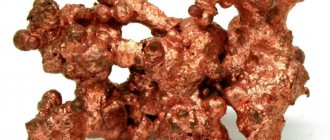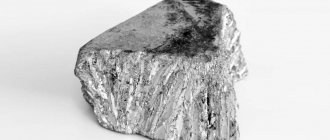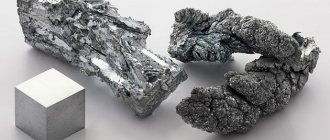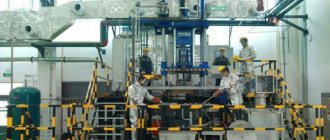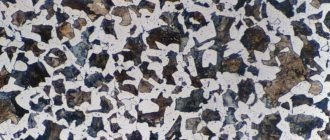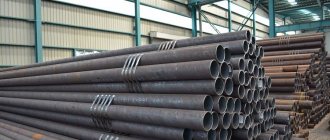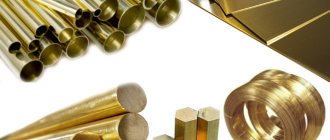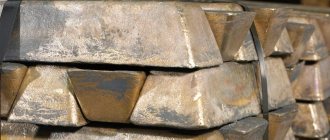The chemical properties of most elements are based on their ability to dissolve in aqueous media and acids. The study of the characteristics of copper is associated with a low-active effect under normal conditions. A feature of its chemical processes is the formation of compounds with ammonia, mercury, nitric and sulfuric acids. The low solubility of copper in water is not capable of causing corrosion processes. It has special chemical properties that allow the compound to be used in various industries.
Item Description
Copper is considered the oldest metal, which people learned to mine even before our era. This substance is obtained from natural sources in the form of ore. Copper is an element of the chemical table with the Latin name cuprum, the serial number of which is 29. In the periodic table it is located in the fourth period and belongs to the first group.
The naturally occurring substance is a pink-red heavy metal with a soft and malleable structure. Its boiling and melting point is more than 1000 °C. Considered a good guide.
Chemical structure and properties
If you study the electronic formula of a copper atom, you will find that it has 4 levels. There is only one electron in the 4s valence orbital. During chemical reactions, from 1 to 3 negatively charged particles can be split off from an atom, then copper compounds with an oxidation state of +3, +2, +1 are obtained. Its divalent derivatives are most stable.
In chemical reactions it acts as a low-reactive metal. Under normal conditions, copper has no solubility in water. Corrosion is not observed in dry air, but when heated, the metal surface becomes covered with a black coating of divalent oxide. The chemical stability of copper is manifested under the action of anhydrous gases, carbon, a number of organic compounds, phenolic resins and alcohols. It is characterized by complex formation reactions with the release of colored compounds. Copper has slight similarities with alkali group metals due to the formation of monovalent derivatives.
It's interesting to know
1. When comparing the properties of copper and alkali metals, a logical question arises: why, given the same type of electronic configuration of the external energy level (for example, 4s1 for K and Cu atoms), are the properties of copper and alkali metals so different? The fact is that the orbital radius of the copper atom (0.119 nm) is significantly smaller than that of potassium (0.216 nm), and the nuclear charge is greater. Therefore, the 4s1 electron in a copper atom is more strongly attracted to the nucleus than in a potassium atom; Accordingly, the first ionization energy of the copper atom (745.4 kJ/mol) is significantly higher than that of the potassium atom (418.8 kJ/mol). However, the second and third ionization energies for copper (1957.9 and 3554 kJ/mol, respectively) are significantly lower than those for potassium (3070.1 and 4.4*103 kJ/mol, respectively), i.e., in the copper atom there are 4s- and 3d electrons are close in energy. This is explained by removing electron(s) from an ion with an electron configuration. 3s23p63d10 (Cu+) is lighter than from an ion with an electron configuration. 3s23p6 (K+). Therefore, unlike alkali metals, copper in compounds can exhibit oxidation states +2, +3 and even + 4.
2. No less interesting is the question of the reasons for the difference in the chemical activity of copper and zinc - metals belonging to the same family, neighbors on the periodic table. The values of the double ionization energy of zinc atoms (1733.3 kJ/mol) are slightly less than those of copper (1957.9 kJ/mol), however, the enthalpy of atomization for zinc (130.5 kJ/mol) is almost three times less than for simple copper substances (339.0 kJ/mol). In other words, the zinc atoms in its crystal are less strongly bonded to each other, which determines the greater chemical activity of the simple substance (not an atom!) of zinc compared to the simple substance copper.
3. When purifying copper using the electrolytic method, the cathode is a sheet of pure copper, the anode is a blank of crude (blister) copper, and the electrolyte is a CuSO4 solution. During electrolysis, the anode dissolves:
Сu0 - 2е ( Cu2+ and copper deposits on the cathode:
Сu2+ - 2е ( Cu0.
In this way, high-purity copper is obtained, containing up to 99.8% copper by weight.
4. For copper in the oxidation state +3, the compounds Cu2O3, (an acidic oxide), K3[CuF6], КCuО2, K[Cu(OH)4], etc. are known. A compound in which the oxidation state of copper is +4 is described: Cs2 [CuF6].
5. Let us explain the reason for the dissolution of copper in hydrohalic acids. The fact is that the electrode potential of the Cu+/Cu system depends on the concentration of Cu+ ions as follows: the lower the concentration of Cu+ ions, the more the electrode potential shifts towards negative values. The formation of a very stable complex H[CuCl2] reduces the concentration of Cu+ ions so much that the electrode potential of the Cu+/Cu system shifts towards negative values and the oxidation of copper atoms by H+ ions becomes possible.
6. The high tendency of copper to form complex compounds is explained by the presence in its atom of vacant and close in energy 4p and 4d orbitals. When a chemical bond is formed, copper usually serves as an electron acceptor, and molecules or ions with lone pairs of electrons (H2O, NH3) serve as electron donors. However, complex compounds are known in which copper, due to lone pairs of electrons in the 3d orbitals, is an electron donor.
7. Copper (I) sulfate can be obtained at 200°C by the reaction:
2Cu + 2H2SO4 ( Cu2SO4 + SO2( + 2H2O.
This salt is stable in air, but decomposes with water into Cu2SO4 and Cu (disproportionates).
What is solubility?
This is the process of formation of homogeneous systems in the form of solutions when one compound interacts with other substances. Their components are individual molecules, atoms, ions and other particles. The degree of solubility is determined by the concentration of the substance that was dissolved when obtaining a saturated solution.
The unit of measurement is most often percentages, volume fractions or weight fractions. The solubility of copper in water, like other solid compounds, is subject only to changes in temperature conditions. This dependence is expressed using curves. If the indicator is very small, then the substance is considered insoluble.
The value of copper for humans
Copper is one of the most important microelements not only for plants. It is found in the human body (100-200 mg) and is produced by the liver. To maintain balance, a person should consume 2 mg of copper daily. Excess mineral turns into poison, because of this you should not cook food in copper utensils.
The benefits of copper cannot be overestimated when it comes to wound healing and body restoration. It has bactericidal properties, helps normalize the functioning of the circulatory system, tissue regeneration, and is used as a component for some medications. In 2 hours, all microbes die on a copper surface, so it is planned to make railings, locks and door handles from this metal for hospitals and other public places.
Copper bracelets and amulets were worn in ancient times not for decoration, but to maintain health. For the same purpose, with the help of nanotechnology, bed and underwear with copper threads were created. It has a beneficial effect on the skin, blood vessels, central nervous system, and musculoskeletal system.
If we analyze the importance of copper and its widespread use, we can say that the copper age continues.
Solubility of copper in aqueous media
The metal exhibits corrosion resistance when exposed to sea water. This proves its inertness under normal conditions. The solubility of copper in water (fresh) is practically not observed. But in a humid environment and under the influence of carbon dioxide, a green film forms on the metal surface, which is the main carbonate:
Cu + Cu + O2 + H2O + CO2 → Cu(OH)2 · CuCO2.
If we consider its monovalent compounds in the form of salts, then their insignificant dissolution is observed. Such substances are subject to rapid oxidation. The result is divalent copper compounds. These salts have good solubility in aqueous media. Their complete dissociation into ions occurs.
Application of copper and its compounds
Due to its high thermal and electrical conductivity, copper is used in large quantities to make electrical wires, cables, boilers, stills, etc.
Copper alloys find a wide variety of applications. Brass (contains up to 45% zinc) is used for the manufacture of radiators, parts of watch mechanisms, and in shipbuilding. Copper-nickel alloys are used in the energy industry, shipbuilding, for the manufacture of thermocouples, and resistance stores. The main purpose of bronze (contains tin or aluminum) is to make bells and statues.
Copper compounds have found the following applications:
Cu2O - as an AC rectifier.
CuO - as an oxidizing agent in laboratory technology, in the production of glass and enamels, as a green and blue dye.
СuSO4 - as a desiccant; СuSO4 • 5Н2О - copper sulfate - for controlling agricultural pests, when impregnating wood to prevent rotting.
(CuOH)2CO3 - for the production of blue and green paints, as an ornamental stone (in the form of malachite).
Solubility of copper in nitric acid
This reaction is possible due to the fact that the process of oxidation of the metal with a strong reagent occurs. Nitric acid in diluted and concentrated form exhibits oxidizing properties with the dissolution of copper.
In the first option, the reaction produces copper nitrate and nitrogen divalent oxide in a ratio of 75% to 25%. The process with dilute nitric acid can be described by the following equation:
8HNO3 + 3Cu → 3Cu(NO3)2 + NO + NO + 4H2O.
In the second case, copper nitrate and nitrogen oxides are obtained, divalent and tetravalent, the ratio of which is 1 to 1. This process involves 1 mole of metal and 3 moles of concentrated nitric acid. When copper dissolves, the solution heats up strongly, resulting in thermal decomposition of the oxidizing agent and the release of an additional volume of nitrogen oxides:
4HNO3 + Cu → Cu(NO3)2 + NO2 + NO2 + 2H2O.
The reaction is used in small-scale production associated with recycling scrap or removing coatings from waste. However, this method of dissolving copper has a number of disadvantages associated with the release of large amounts of nitrogen oxides. To capture or neutralize them, special equipment is required. These processes are very expensive.
The dissolution of copper is considered complete when the production of volatile nitrogen oxides completely ceases. The reaction temperature ranges from 60 to 70 °C. The next step is to drain the solution from the chemical reactor. At its bottom there are small pieces of metal that have not reacted. Water is added to the resulting liquid and filtered.
Physical properties of copper
Pure copper is a metal whose color ranges from pink to red. The radius of positively charged copper ions can take the following values:
- with a coordination index of 6 - up to 0.091 nm
- with a coordination index of 2 - up to 0.06 nm.
The radius of the copper atom is 0.128 nm. The electron affinity reaches 1.8 eV. The process of ionization of a given atom increases the electron affinity from 7.726 to 82.7 eV. Copper is a transition metal. The value of its electronegativity reaches 1.9 units on the Pauling scale. It is worth noting that the oxidation state can take on different values. At temperatures ranging from 20 to 100 degrees, the thermal conductivity is 394 W/m*K. The electrical conductivity index of copper, in terms of which it is second only to silver, ranges from 55.5–58 MS/m.
Since copper in the potential series is located to the right of hydrogen, it is not able to displace this element from water and various types of acids. Copper has a face-centered cubic crystal lattice, and its value reaches 0.36150 nm. Copper begins to melt at a temperature of 1083 degrees, and it boils at 26570 degrees. The density of copper is determined by its physical properties and is 8.92 g/cm3. In addition to the above, it is worth highlighting the following physical and mechanical properties of copper:
- the thermal linear expansion index is 0.00000017 units
- the tensile strength indicator reaches 22 kgf/mm2
- copper hardness level on the Brinell scale is 35 kgf/mm2
- specific gravity is 8.94 g/cm3
- elasticity index is 132000 Mn/m2
- relative elongation is 60%.
The magnetic properties of this metal, which is completely diamagnetic, can be called absolutely unique. It is thanks to these indicators, together with physical properties, for example, specific gravity and conductivity, that one can explain such a wide popularity of this metal in the production of electrical products. Aluminum has somewhat similar properties, which is also actively used in the manufacture of various electrical products, for example, wires, cables and other things. The only characteristic of copper that can be changed is its tensile strength. This indicator can be improved almost twice (up to 420–450 MN/m2) through a special technological operation called cold hardening.
Solubility in sulfuric acid
Under normal conditions, this reaction does not occur. The factor determining the dissolution of copper in sulfuric acid is its strong concentration. A dilute medium cannot oxidize the metal. The dissolution of copper in concentrated sulfuric acid proceeds with the release of sulfate.
The process is expressed by the following equation:
Cu + H2SO4 + H2SO4 → CuSO4 + 2H2O + SO2.
What is copper made from?
Sources for copper production are ores, minerals and secondary raw materials. Metal is obtained from ore using two methods:
- Pyrometallurgical (main). Raw copper is enriched and subjected to flotation and roasting. In this way, concentrates containing 8-25% Cu are made from copper ore. This is followed by oxidizing roasting, smelting, blowing and refining, when the copper is cleared of impurities. Precious metals are recovered along the way. The method is suitable even for ores in which the copper content does not reach 0.5%.
- Hydrometallurgical. The metal is leached with sulfuric acid and then separated from the resulting solution. It is used for poor ores, without the possibility of obtaining precious metals.
Recycled raw materials can be pre-processed and then melted. It produces a metal with a copper content of 99%.
Properties of copper sulfate
Dibasic salt is also called sulfuric acid and is designated as CuSO4. It is a substance without a characteristic odor and does not exhibit volatility. In its anhydrous form, salt is colorless, opaque, and highly hygroscopic. Copper (sulfate) has good solubility. Water molecules, when added to salt, can form crystalline hydrate compounds. An example is copper sulfate, which is a blue pentahydrate. Its formula: CuSO4·5H2O.
Crystalline hydrates have a transparent structure with a bluish tint and exhibit a bitter, metallic taste. Their molecules are capable of losing bound water over time. They are found in nature in the form of minerals, which include chalcanthite and butite.
Susceptible to copper sulfate. Solubility is an exothermic reaction. The process of salt hydration generates a significant amount of heat.
Copper, properties, compounds, alloys, production, application
Copper
Copper (lat. Cuprum) is a chemical element of group I of the periodic system of Mendeleev (atomic number 29, atomic mass 63.546). In compounds, copper usually exhibits oxidation states +1 and +2; a few trivalent copper compounds are also known. The most important copper compounds: oxides Cu2O, CuO, Cu2O3; hydroxide Cu(OH)2, nitrate Cu(NO3)2.3H2O, sulfide CuS, sulfate (copper sulfate) CuSO4.5H2O, carbonate CuCO3Cu(OH)2, chloride CuCl2.2H2O.
Copper is one of the seven metals known since ancient times. The transition period from the Stone to the Bronze Age (4th - 3rd millennium BC) was called the Copper Age or Chalcolithic (from the Greek chalkos - copper and lithos - stone) or Chalcolithic (from the Latin aeneus - copper and Greek lithos - stone) . Copper tools appeared during this period. It is known that copper tools were used during the construction of the Cheops pyramid.
Pure copper is a malleable and soft metal of a reddish color, pink when fractured, in places with brown and mottled tarnish, heavy (density 8.93 g/cm3), an excellent conductor of heat and electricity, second in this regard only to silver (melting point 1083 °C ). Copper is easily drawn into wire and rolled into thin sheets, but has relatively little activity. In dry air and oxygen under normal conditions, copper does not oxidize. But it reacts quite easily: already at room temperature it forms CuCl2 chloride with halogens, for example with wet chlorine; when heated with sulfur it forms Cu2S sulfide, with selenium. But copper does not interact with hydrogen, carbon and nitrogen even at high temperatures. Acids that do not have oxidizing properties do not act on copper, for example, hydrochloric and dilute sulfuric acids. But in the presence of atmospheric oxygen, copper dissolves in these acids to form the corresponding salts: 2Cu + 4HCl + O2 = 2CuCl2 + 2H2O.
In an atmosphere containing CO2, H2O vapors, etc., it becomes covered with patina - a greenish film of basic carbonate (Cu2(OH)2CO3)), a toxic substance.
Copper is found in more than 170 minerals, of which only 17 are important for industry, including: bornite (variegated copper ore - Cu5FeS4), chalcopyrite (copper pyrite - CuFeS2), chalcocite (copper luster - Cu2S), covellite (CuS), malachite (Cu2(OH)2CO3). Native copper is also found.
Copper density, specific gravity of copper and other characteristics of copper
Density - 8.93*103kg/m3; Specific gravity - 8.93 g/cm3; Specific heat capacity at 20 °C - 0.094 cal/deg; Melting point - 1083 °C; Specific heat of fusion - 42 cal/g; Boiling point - 2600 °C; Linear expansion coefficient (at a temperature of about 20 °C) - 16.7 * 106 (1/deg); Thermal conductivity coefficient - 335 kcal/m*hour*deg; Specific resistance at 20 °C - 0.0167 Ohm*mm2/m;
Copper elastic moduli and Poisson's ratio
| Name of material | Young's modulus, kg/mm2 | Shear modulus, kg/mm2 | Poisson's ratio |
| Copper, casting | 8400 | — | — |
| Rolled copper | 11000 | 4000 | 0,31-0,34 |
| Cold drawn copper | 13000 | 4900 | — |
COPPER COMPOUNDS
Copper (I) oxide Cu2O3 and cuprous oxide (I) Cu2O , like other copper (I) compounds, are less stable than copper (II) compounds. Copper (I) oxide, or cuprous oxide Cu2O, occurs naturally as the mineral cuprite. In addition, it can be obtained as a precipitate of red copper(I) oxide by heating a solution of a copper(II) salt and an alkali in the presence of a strong reducing agent.
Copper(II) oxide , or copper oxide, CuO is a black substance found in nature (for example, in the form of the mineral tenerite). It is obtained by calcination of copper (II) hydroxycarbonate (CuOH)2CO3 or copper (II) nitrate Cu(NO2)2. Copper(II) oxide is a good oxidizing agent. Copper (II) hydroxide Cu(OH)2 precipitates from solutions of copper (II) salts under the action of alkalis in the form of a blue gelatinous mass. Even with low heating, even under water, it decomposes, turning into black copper (II) oxide. Copper(II) hydroxide is a very weak base. Therefore, solutions of copper (II) salts in most cases have an acidic reaction, and with weak acids copper forms basic salts.
Copper (II) sulfate CuSO4 in the anhydrous state is a white powder that turns blue when it absorbs water. Therefore, it is used to detect traces of moisture in organic liquids. An aqueous solution of copper sulfate has a characteristic blue-blue color. This color is characteristic of hydrated [Cu(H2O)4]2+ ions, therefore all dilute solutions of copper (II) salts have the same color, unless they contain any colored anions. From aqueous solutions, copper sulfate crystallizes with five molecules of water, forming transparent blue crystals of copper sulfate. Copper sulfate is used for electrolytic coating of metals with copper, for the preparation of mineral paints, and also as a starting material in the preparation of other copper compounds. In agriculture, a diluted solution of copper sulfate is used to spray plants and treat grain before sowing to destroy spores of harmful fungi.
Copper (II) chloride CuCl2. 2H2O . Forms dark green crystals, easily soluble in water. Very concentrated solutions of copper (II) chloride are green, diluted solutions are blue-blue.
Copper(II) nitrate Cu(NO3)2.3H2O . It is obtained by dissolving copper in nitric acid. When heated, blue copper nitrate crystals first lose water and then easily decompose, releasing oxygen and brown nitrogen dioxide, turning into copper (II) oxide.
Copper (II) hydroxycarbonate (CuOH)2CO3 . It occurs naturally in the form of the mineral malachite, which has a beautiful emerald green color. It is artificially prepared by the action of Na2CO3 on solutions of copper (II) salts. 2CuSO4 + 2Na2CO3 + H2O = (CuOH)2CO3↓ + 2Na2SO4 + CO2↑ It is used to obtain copper (II) chloride, for the preparation of blue and green mineral paints, as well as in pyrotechnics.
Copper(II) acetate Cu(CH3COO)2.H2O . It is obtained by treating copper metal or copper(II) oxide with acetic acid. Usually it is a mixture of basic salts of various compositions and colors (green and blue-green). Under the name verdigris, it is used to prepare oil paint.
Complex copper compounds are formed as a result of the combination of doubly charged copper ions with ammonia molecules. A variety of mineral paints are obtained from copper salts. All copper salts are poisonous. Therefore, to avoid the formation of copper salts, copper utensils are coated on the inside with a layer of tin (tinned).
COPPER PRODUCTION
Copper is mined from oxide and sulfide ores. 80% of all mined copper is smelted from sulfide ores. Typically, copper ores contain a lot of gangue. Therefore, a beneficiation process is used to obtain copper. Copper is obtained by smelting it from sulfide ores. The process consists of a number of operations: roasting, smelting, converting, fire and electrolytic refining. During the firing process, most of the impurity sulfides are converted into oxides. Thus, the main impurity of most copper ores, pyrite FeS2, turns into Fe2O3. The gases produced during roasting contain CO2, which is used to produce sulfuric acid. The resulting oxides of iron, zinc and other impurities during the firing process are separated in the form of slag during melting. Liquid copper matte (Cu2S with an admixture of FeS) enters the converter, where air is blown through it. During conversion, sulfur dioxide is released and crude or raw copper is obtained. To extract valuable (Au, Ag, Te, etc.) and to remove harmful impurities, blister copper is first subjected to fire and then electrolytic refining. During fire refining, liquid copper is saturated with oxygen. In this case, impurities of iron, zinc and cobalt are oxidized, turn into slag and are removed. And copper is poured into molds. The resulting castings serve as anodes during electrolytic refining. The main component of the solution during electrolytic refining is copper sulfate - the most common and cheapest copper salt. To increase the low electrical conductivity of copper sulfate, sulfuric acid is added to the electrolyte. And to obtain a compact copper deposit, a small amount of additives is introduced into the solution. Metal impurities contained in crude (“blister”) copper can be divided into two groups.
1)Fe, Zn, Ni, Co. These metals have significantly more negative electrode potentials than copper. Therefore, they anodicly dissolve together with copper, but are not deposited on the cathode, but accumulate in the electrolyte in the form of sulfates. Therefore, the electrolyte must be replaced periodically.
2)Au, Ag, Pb, Sn. Noble metals (Au, Ag) do not undergo anodic dissolution, but during the process they settle at the anode, forming anode sludge together with other impurities, which is periodically removed. Tin and lead dissolve together with copper, but in the electrolyte they form poorly soluble compounds that precipitate and are also removed.
COPPER ALLOYS
Alloys that increase the strength and other properties of copper are obtained by introducing additives into it, such as zinc, tin, silicon, lead, aluminum, manganese, and nickel. More than 30% of copper is used for alloys.
Brasses are alloys of copper and zinc (copper from 60 to 90% and zinc from 40 to 10%) - stronger than copper and less susceptible to oxidation. When silicon and lead are added to brass, its anti-friction qualities increase; when tin, aluminum, manganese and nickel are added, its anti-corrosion resistance increases. Sheets and cast products are used in mechanical engineering, especially in chemical, optics and instrument making, and in the production of meshes for the pulp and paper industry.
Bronze . Previously, bronzes were alloys of copper (80-94%) and tin (20-6%). Currently, tin-free bronzes are produced, named after the main component after copper.
Aluminum bronzes contain 5-11% aluminum and have high mechanical properties combined with anti-corrosion resistance.
Lead bronzes containing 25-33% lead are used mainly for the manufacture of bearings operating at high pressures and high sliding speeds.
Silicon bronzes containing 4-5% silicon are used as cheap substitutes for tin bronzes.
Beryllium bronzes , containing 1.8-2.3% beryllium, are distinguished by hardness after hardening and high elasticity. They are used for the manufacture of springs and spring products.
Cadmium bronzes - copper alloys with a small amount of cadmium (up to 1%) - are used for the manufacture of fittings for water and gas lines and in mechanical engineering.
Solders are alloys of non-ferrous metals used in soldering to produce a monolithic soldered seam. Among hard solders, copper-silver alloy is known (44.5-45.5% Ag; 29-31% Cu; the rest is zinc).
USES OF COPPER
Copper, its compounds and alloys are widely used in various industries.
In electrical engineering, copper is used in its pure form: in the production of cable products, busbars of bare and contact wires, electric generators, telephone and telegraph equipment and radio equipment. Heat exchangers, vacuum devices, and pipelines are made from copper. More than 30% of copper goes to alloys.
Alloys of copper with other metals are used in mechanical engineering, in the automotive and tractor industries (radiators, bearings), and for the manufacture of chemical equipment.
The high viscosity and ductility of the metal make it possible to use copper for the manufacture of a variety of products with very complex patterns. Red copper wire in the annealed state becomes so soft and flexible that you can easily twist all kinds of cords from it and bend the most complex ornamental elements. In addition, copper wire is easily soldered with hard silver solder and is well silvered and gold-plated. These properties of copper make it an indispensable material in the production of filigree products.
The coefficient of linear and volumetric expansion of copper when heated is approximately the same as that of hot enamels, and therefore, when cooled, the enamel adheres well to the copper product and does not crack or bounce off. Thanks to this, craftsmen prefer copper to all other metals for the production of enamel products.
Like some other metals, copper is one of the vital trace elements . It is involved in the process of photosynthesis and the absorption of nitrogen by plants, promotes the synthesis of sugar, proteins, starch, and vitamins. Most often, copper is added to the soil in the form of pentahydrate sulfate - copper sulfate CuSO4.5H2O. In large quantities it is poisonous, like many other copper compounds, especially for lower organisms. In small doses, copper is necessary for all living things.
Solubility of copper in iron
As a result of this process, pseudo-alloys of Fe and Cu are formed. For metallic iron and copper, limited mutual solubility is possible. Its maximum values are observed at a temperature of 1099.85 °C. The degree of solubility of copper in the solid form of iron is 8.5%. These are small numbers. The dissolution of metallic iron in the solid form of copper is about 4.2%.
Reducing the temperature to room values makes the mutual processes insignificant. When metallic copper is melted, it is able to well wet iron in solid form. When producing Fe and Cu pseudo-alloys, special blanks are used. They are created by pressing or baking iron powder in pure or alloyed form. Such workpieces are impregnated with liquid copper, forming pseudo-alloys.
Popular message topics
- Human feelings
Feelings are formed in the process of human development. They form emotional stability, the ability to experience a specific feeling or emotion. A person is sensitive, and this is determined by physical and emotional sensations. - Flowers Dahlias
Dahlias became popular back in the second century of the last century. It grows in gardens and personal plots. Everything changes and gradually the fashion for flowers also changed. - Microscope
Our world is very rich, but often all the wealth is stored in small things. They are so small that it is impossible to see them with the eyes. But I really want to see all the beauty, all the grace. This is why the microscope was invented.
Dissolution in ammonia
The process often occurs by passing NH3 in gaseous form over hot metal. The result is the dissolution of copper in ammonia, the release of Cu3N. This compound is called monovalent nitride.
Its salts are exposed to ammonia solution. The addition of such a reagent to copper chloride leads to the formation of a precipitate in the form of hydroxide:
CuCl2 + NH3 + NH3 + 2H2O → 2NH4Cl + Cu(OH)2↓.
Excess ammonia promotes the formation of a complex type compound that is dark blue in color:
Cu(OH)2↓+ 4NH3 → [Cu(NH3)4] (OH)2.
This process is used to determine cupric ions.
Solubility in cast iron
In the structure of malleable pearlitic cast iron, in addition to the main components, there is an additional element in the form of ordinary copper. It is this that increases the graphitization of carbon atoms and helps to increase the fluidity, strength and hardness of alloys. The metal has a positive effect on the level of perlite in the final product. The solubility of copper in cast iron is used to alloy the original composition. The main purpose of this process is to obtain a malleable alloy. It will have increased mechanical and corrosion properties, but reduced embrittlement.
If the copper content in cast iron is about 1%, then the tensile strength is equal to 40%, and the yield strength increases to 50%. This significantly changes the characteristics of the alloy. Increasing the amount of metal alloying to 2% leads to a change in strength to 65%, and the fluidity rate becomes 70%. With a higher copper content in cast iron, spheroidal graphite is more difficult to form. The introduction of an alloying element into the structure does not change the technology for forming a viscous and soft alloy. The time allotted for annealing coincides with the duration of such a reaction in the production of cast iron without copper admixture. It is about 10 hours.
The use of copper for the production of cast iron with a high silicon concentration is not able to completely eliminate the so-called ferruginization of the mixture during annealing. The result is a product with low elasticity.
Copper grades
Copper marking begins with the letter "M" . The number following it shows the purity of the metal:
- MOO: 99.99% Cu;
- MO: 99.97%;
- M1: 99.9%;
- M2: 99.7%;
- M3: 99.5%;
- M4: 99%.
Oxygen significantly reduces the strength of copper, so its content is implied in the marking. Brands with numbers 1, 2, 3 contain 0.5-0.8% oxygen, MO - 0.02%, MOb - 0%. The presence of phosphorus is indicated by the letters “p” (at a small percentage) and “f” (more than 0.4%). The letter "k" refers to copper cathode. Some countries have adopted their own labeling that does not correspond to the Russian one.
There are 2 types of copper – pure and technical. The latter is used for the production of semi-finished products and smelting of alloys. Impurities of other chemical elements to one degree or another affect the properties of Cu. For example:
- Nickel reduces thermal conductivity, and tin enhances it.
- Bismuth worsens the technical characteristics, and arsenic neutralizes the effect of the former, remaining neutral with respect to copper.
- Antimony and silicon reduce the ability to conduct heat and electricity.
- Sulfur and selenium in certain quantities impair plasticity.
- Lead and bismuth make pressure processing difficult.
- Phosphorus removes oxygen, which causes physical properties to deteriorate.
- Impurities such as zinc, manganese, arsenic, nickel, and silver practically do not change the physical characteristics of copper.
Solubility in mercury
When mercury is mixed with metals of other elements, amalgams are obtained. This process can take place at room temperature, because under such conditions Pb is a liquid. The solubility of copper in mercury disappears only during heating. The metal must first be crushed. When solid copper is wetted with liquid mercury, mutual penetration of one substance into another or a process of diffusion occurs. The solubility value is expressed as a percentage and is 7.4*10-3. The reaction produces a hard, simple amalgam similar to cement. If you heat it up a little, it softens. As a result, this mixture is used to repair porcelain products. There are also complex amalgams with an optimal content of metals. For example, dental alloy contains the elements silver, tin, copper and zinc. Their percentage ratio is 65: 27: 6:2. Amalgam with this composition is called silver. Each component of the alloy performs a specific function, which allows you to obtain a high-quality filling.
Another example is an amalgam alloy, which has a high copper content. It is also called copper alloy. The amalgam contains from 10 to 30% Cu. The high copper content prevents the interaction of tin with mercury, which prevents the formation of a very weak and corrosive phase of the alloy. In addition, reducing the amount of silver in a filling leads to cheaper prices. To prepare amalgam, it is advisable to use an inert atmosphere or a protective liquid that forms a film. The metals that make up the alloy can be quickly oxidized by air. The process of heating cuprum amalgam in the presence of hydrogen causes the mercury to be distilled off, allowing the elemental copper to be separated. As you can see, this topic is not difficult to learn. Now you know how copper interacts not only with water, but also with acids and other elements.
Copper abundance
The prevalence of such a chemical element as copper is quite wide. In terms of abundance in the earth's crust, copper ranks 23rd. Its content in the earth's crust is estimated at 0.006%. This chemical element is one of the few that is found in nature in native form. Today, there are more than 3,000 known places around the world where copper is mined. The most fertile deposits are found in countries such as Chile, Russia and the USA. Today, more than 50 countries around the world have copper mines.
It is also worth noting that copper is mostly mined as part of minerals, since it is quite rare in its natural form. To date, over 600 minerals that contain copper are known. The most valuable of them are chalcopyrite, chalcocite, bornite, atacamite and malachite. The percentage of copper in these minerals exceeds 60%.
As for the prevalence in the universe, not everything is so simple. It is not possible to determine its prevalence due to the small amount of information. Only its presence on the moon and Mars is known from samples taken from these cosmic bodies. The estimated concentration is not considered small.
Read: Iron as a chemical element on the periodic table

